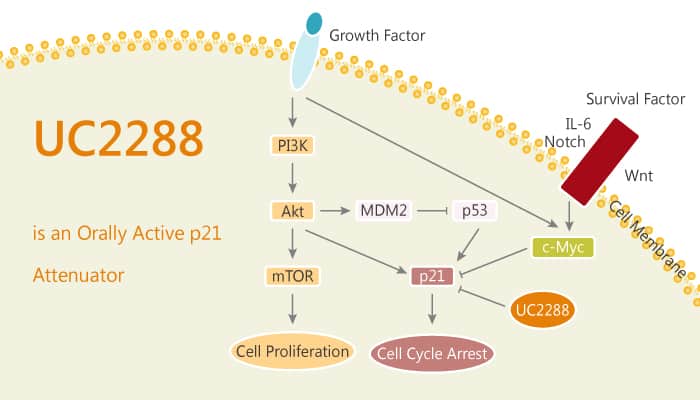p21 is a member of the cip/kip family of cyclin-dependent kinase inhibitors, it regulates cell growth in both malignant or non-malignant cells. It possesses diverse physiological functions in vitro, such as vascular smooth muscle cell proliferation, cancer progression, and viral infection. p21 is well-known as a tumor suppressor protein downstream of p53 signaling pathways. But it is studied as a marker of cancer prognosis, it is also going to be a novel target for cancer therapy.
In this article, we will introduce a potent p21 attenuator, UC2288.

UC2288 is a cell-permeable, and orally active p21 attenuator, which exhibiting relatively selective activity for p21. This compound is synthesized based on Sorafenib. UC2288 decreases p21 mRNA expression independently of p53 and attenuates p21 protein levels with minimal effect on p21 protein stability. UC2288 has no inhibition of VEGFR2 and Raf kinases even at 10 μM.
Firstly, in vitro, in HK2, 786-O, Caki-1, ACHN, and HEY (ovarian cancer) cells, UC2288 decreases the p21 protein level in a concentration-dependent manner. However, it has no effects on other proteins. Besides, UC2288 decreases p21 mRNA expression transcriptionally or post-transcriptionally, but independently of p53.
In vivo, in athymic nude (NCr nu/nu) mice with HCT116 and ACHN cancer cells, UC2288 alone has fewer effects on tumor growth. However, when it combines with imetelstat, this combination suppresses tumor growth and does not affect mice’s weight.
In MPTP-induced C57BL6 Parkinson’s disease mice model. MPTP activates the MAPK pathway in the mice brain, meanwhile, it raises TNF-α, IL-6, and IL-1β levels in MPTP-treated mice brain.
UC2288 treatment prevents MPTP-induced activation of the MAPK pathway, significantly decreases MPTP-induced TNF-α, IL-6 levels, but IL-1β is not decreased in the brain. In a word, UC2288 ameliorates MPTP-induced PD progression through inhibition of neuroinflammation.
In summary, as a new generation p21 inhibitor, UC2288 attenuates p21 protein abundance in vitro and in vivo. It has a bright promising for cancer research.
reference:
[1]. Hiromi I Wettersten, et al. Cancer Biol Ther. 2013 Mar;14(3):278-85.
[2]. Romi Gupta, et al. Proc Natl Acad Sci U S A. 2014 Jul 29;111(30): E3062-71.